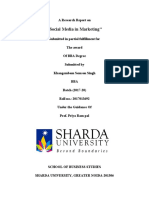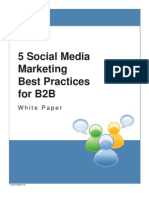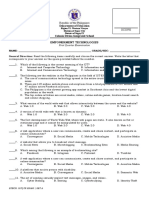Special Report: Social Media - Creating A Tactical Plan of Action
Special Report: Social Media - Creating A Tactical Plan of Action
Uploaded by
Manuela BianchiCopyright:
Available Formats
Special Report: Social Media - Creating A Tactical Plan of Action
Special Report: Social Media - Creating A Tactical Plan of Action
Uploaded by
Manuela BianchiOriginal Title
Copyright
Available Formats
Share this document
Did you find this document useful?
Is this content inappropriate?
Copyright:
Available Formats
Special Report: Social Media - Creating A Tactical Plan of Action
Special Report: Social Media - Creating A Tactical Plan of Action
Uploaded by
Manuela BianchiCopyright:
Available Formats
1
Special Report:
Social Media
Creating a Tactical
Plan of Action
Brought to you courtesy of:
2
1
Protect and promote your brand with Vocus.
Vocus completely integrates social and traditional media to give you tracking, reporting,
analysis, news distribution and the worlds most comprehensive database of media and
influencer contacts all in one place.
Join thousands of organizations of all sizes who use Vocus to:
Extend your network With access to a global media database, you can
connect to more than 1.4 million journalists, media outlets, bloggers, analysts,
opportunities and more.
Monitor everything Track mentions, tweets, blogs, comments, in traditional
and social media coverage, side-by-side.
Broaden your reach Send your news directly to critical influencers for targeted
outreach, or across the web with PRWeb.
Measure every ounce of impact Gain immediate insight into the effectiveness
of your programs, industry trends and traction of your competitors with easy-to-
read charts, graphs and reports.
Enjoy amazing customer service We love what we do, and make sure you
get the most out of your investment in Vocus. Call, tweet, or email and well be
there.
www.vocus.com
In just one year, we tripled media coverage, reduced the amount of negative news, and
increased the amount of impressions with the correct use of the organization's name and
key messaging by 535 percent.
The Humane Society of the United States
3
MarketingSherpas Social Marketing ROAD Map Handbook
48
Copyright 20002010 MarketingSherpa LLC. It is forbidden to copy this report in any manner.
For permissions contact service@sherpastore.com. For more copies, visit http://www.SherpaStore.com
CHAPTER 3: ROAD MAP ACTIONS
CREATING A SOCIAL MARKETING STRATEGY WITH A TACTICAL PLAN OF ACTION
The third step in the ROAD Map methodology is Actions. In the previous steps, we established where we
are now in the scheme of social media marketing and where we are going. In this step, we will define a
tactical plan of action that will show us how to get there from here.
The tactical plan is the heartbeat of a social marketing strategy. While the tactics will use social media to
achieve your objectives, they should be technology-agnostic meaning they should outlive the temporary
lifespan of todays leading technology brands. For example, an enduring tactic would be to build and
participate in a network populated by our targeted audience, not create a Facebook fan page. Focusing
on the implementation of technologies instead of tactics for achieving objectives leads to ineffectiveness.
TACTICAL EFFECTIVENESS VERSUS FAST AND EASY IMPLEMENTATION
CHART: COMPARING THE EFFECTIVENESS, EFFORT REQUIRED AND USAGE OF SOCIAL MARKETING TACTICS
Social
networks
Multimedia
content sharing
Microblogging
Blogging
SMNR
Social media SEO
Blogger relations
Adv
Email content
sharing
0%
3%
6%
9%
12%
15%
18%
0% 5% 10% 15% 20% 25%
M
o
s
t
E
f
f
e
c
t
i
v
e
Most Effort Required
Sphere Size Indicates Level of Usage
Source / Methodology: MarketingSherpa Social Media Marketing Benchmark Survey / Fielded Nov 2009, N=2,317
4
MarketingSherpas Social Marketing ROAD Map Handbook
49
Copyright 20002010 MarketingSherpa LLC. It is forbidden to copy this report in any manner.
For permissions contact service@sherpastore.com. For more copies, visit http://www.SherpaStore.com
In the chart on the previous page, we combine three sets of data the usage, effort required and
effectiveness of social marketing tactics to give you a three dimensional view of the tactical use.
The effort (time and resources) required of a social marketing tactic often trumps the effectiveness of a
tactic in determining its use. The more effort required, the less likely it will be implemented. For example,
the most effective tactic shown in the chart above blogger relations is used by far fewer organizations
than less effective tactics primarily because of the effort required.
This focus on fast and easy versus effectiveness is a problem that is far more prevalent with organizations
in the trial phase of social marketing maturity than with more advanced social marketers working from a
strategic social marketing plan.
5
MarketingSherpas Social Marketing ROAD Map Handbook
50
Copyright 20002010 MarketingSherpa LLC. It is forbidden to copy this report in any manner.
For permissions contact service@sherpastore.com. For more copies, visit http://www.SherpaStore.com
TACTICS FOR THE EFFECTIVE USE OF SOCIAL MEDIA PLATFORMS
GUIDING PRINCIPLES
One of the biggest challenges to devising a tactical plan of action for social media is changing the thought
processes of marketers who have long been accustomed to one-way messaging. The following are a few
guiding principles for helping marketers adapt to the use of social media for marketing purposes:
Its transparent be who you are: This means no pseudonyms. And write in your own words.
Show a little personality and a bit of your personal self. Being genuine will increase your
believability, give you credibility and allow you to deal with the important issues.
Its personal focus on the individual: Social media is not the place for mass communications.
Participation in social networks, communities and other social sites is for the individual, by the
individual. Its okay to have branded sites but not to author posts in the name of The Company.
Its a conversation join it: Social media means your brand is no longer what you say it is; its what
they say it is. By they, we are referring to your prospects, customers and other influencers who
are talking about your brand, products and competition during the purchase process. Only by
joining in these conversations can you hope to influence the outcome.
Its viral for better or worse: One of the key attractions of using social media for marketing
purposes is the viral effect. We create social campaigns in the hopes it will go viral, reaching
throngs of social media users at little or no additional cost. But this can also work against us just
ask the executive caught disparaging his company on a YouTube video!
The following pages provide an overview of key social media tactics and insights for incorporating them into
your social marketing plan of action.
6
MarketingSherpas Social Marketing ROAD Map Handbook
51
Copyright 20002010 MarketingSherpa LLC. It is forbidden to copy this report in any manner.
For permissions contact service@sherpastore.com. For more copies, visit http://www.SherpaStore.com
BLOGGING
The blog has become the hub of the social marketing strategy in the same way that the website has
become the hub of the marketing strategy for many organizations. Blogs play a key role in attracting and
building relationships with prospects, and channeling them to the website for conversion to leads and
customers.
Blogs also play a key role in boosting organic search engine rankings. The dynamic nature of blog content is
search engine friendly. It also provides other sites with linkable content, increasing the number of inbound
links to your blog. These factors combine to greatly increase the likelihood of appearing on the first page of
search engine listings.
Blogging is used to build relationships by allowing a company to communicate in a personal way that
enables feedback in the form of reader commentary. Sharing relevant content provides value to prospects
and customers while demonstrating the thought-leadership of the organization. Blogs may feature posts
from a single representative, like the CEO, or from a number of people representing their individual areas of
expertise.
BLOGGING TACTICS AND BEST PRACTICES
Brand and personify your blog. In the pursuit of building personalized relationships and thought-
leadership status, brand building goals are often take a back seat. Remember why youre blogging.
Be engaging. Blogging is about engaging your audience in two-way conversation. Write or source
compelling content with the goal of triggering a reaction and commentary from your readers.
Define your community. Displaying a blog roll is a great way to tell readers what content is
relevant to the topic you are writing about and where to find it.
Plan your content mix. An editorial plan will help you create an interesting mix of posts and
manage resources. Vary the type of content used from personal viewpoints to research charts.
Drive conversions. If a website is your primary point of lead conversion, add links to your posts
that drive readers to landing pages with registration forms to download more information.
CHART: RATING THE TACTICAL EFFECTIVENESS OF BLOGGING
10% 23% 28% 29% 10%
Blogging on company branded or
managed blogs
1 least effective 2 3 4 5 most effective
Source / Methodology: MarketingSherpa Social Media Marketing Benchmark Survey / Fielded Nov 2009, N=2,317
7
MarketingSherpas Social Marketing ROAD Map Handbook
52
Copyright 20002010 MarketingSherpa LLC. It is forbidden to copy this report in any manner.
For permissions contact service@sherpastore.com. For more copies, visit http://www.SherpaStore.com
MICROBLOGGING
A microblog combines the information value of blogs with the brevity of texting and community building of
social networks. The beauty in this platform lies in its simplicity. Microblogs let you write brief posts, usually
no more than 140 characters, which are received by anyone who wishes to follow your stream. One of the
appeals of microblogging, and a reason for its rapid growth, is its ease of use on mobile devices.
Microblogging delivers brief, real-time insights with the ability to link the followers with additional content,
all in an opt-in, permission-based marketing environment.
There are many types and brands of microblog platforms, including Yammer, Jaiku and Foursquare, but the
prevailing platform is Twitter. The following tactics and best practices may appear to be Twitter-oriented
but are often applicable to most types of microblog platforms.
MICROBLOGGING TACTICS AND BEST PRACTICES
Build a following. Search the microblog for accounts that use the keywords of interest to your
target audience and follow them. This often generates reciprocal follows from relevant accounts.
Post messages optimized for your important keywords that will be found and followed by others.
Post a relevant mix. The goal is to link traffic to points of conversion (website landing pages, etc.)
but a mix of messages with links to third party content, tips, etc. is a more balanced approach.
Use replies and direct messages. Individually engage those you are following privately with direct
messaging or publicly with an @ reply.
Hashtag it. Want to track and attract an audience to a unique topic keyword? On Twitter, add the
hashtag symbol # to the keyword. The hashtag for the topic of this handbook is #SherpaROAD.
Leverage applications. There is a plethora of Twitter tools to manage microblogging, including:
o TwitterFriends for stats and network monitoring
o TweetDeck for organizing followers and topics
o TwitPic for uploading photos
o Twitter Search for finding topics of interest
o Twellow for finding people
CHART: RATING THE TACTICAL EFFECTIVENESS OF MICROBLOGGING
13% 20% 32% 24% 11%
Microblogging on company
branded or managed microblogs
(Twitter, Jaiku, etc.)
1 least effective 2 3 4 5 most effective
Source / Methodology: MarketingSherpa Social Media Marketing Benchmark Survey / Fielded Nov 2009, N=2,317
8
MarketingSherpas Social Marketing ROAD Map Handbook
53
Copyright 20002010 MarketingSherpa LLC. It is forbidden to copy this report in any manner.
For permissions contact service@sherpastore.com. For more copies, visit http://www.SherpaStore.com
SOCIAL NETWORKING
Once simply an online space for personal and professional networking, social networks are evolving into a
world of opportunities for brands and industry thought-leaders. Marketers were watching closely as the
consumer population of this new world grew to reach the critical mass of a viable market. The developers
of these popular social networking platforms were also watching for opportunities to leverage this growing
population for marketing purposes.
Facebook Fan Pages, LinkedIn Events and other commercially-oriented functionality are transforming
mainstream social networks to effectively support a new category of marketing tactics. On a smaller scale,
branded or purpose-driven social networks that function similarly to networks like Facebook and LinkedIn
are being custom created outside the mainstream for niche purposes. DIY platforms like Ning provide the
tools to build a custom social network around your brand or for reaching out to any significant group of
people with common interests. How to use these platforms for achieving business goals varies greatly
depending on the marketing situation, but a few basic tactics and principles are universal.
SOCIAL NETWORKING TACTICS AND BEST PRACTICES
Build a community. Building a community for your brand on a social network like Facebook Fan
Pages is similar to building a following of friends. Instead of friends, individuals become fans.
Instigate a mob mentality. Attract like-minded people to share common interests by creating,
moderating and participating in discussion groups on topics relevant to your brand.
Make it eventful. Business events like webinars, conferences and training programs can be posted
and promoted using invitations to build attendance.
Q&A. Social network features like LinkedIn Answers allow you to ask thought-provoking questions
and become an expert by providing valuable answers while demonstrating thought leadership.
Post a relevant mix. The goal is to link traffic to points of conversion (website landing pages, etc.)
but a mix of messages with links to third party content, tips, etc. is a more balanced approach.
Gather insights interactively. Surveying fans and polling contacts is another way to actively engage
your community in topics of mutual interest while providing market research and insights.
CHART: RATING THE TACTICAL EFFECTIVENESS OF SOCIAL NETWORKING
15% 24% 31% 22% 8%
Participating on company branded
or managed social networks
(Facebook, LinkedIn, etc.)
1 least effective 2 3 4 5 most effective
Source / Methodology: MarketingSherpa Social Media Marketing Benchmark Survey / Fielded Nov 2009, N=2,317
9
MarketingSherpas Social Marketing ROAD Map Handbook
54
Copyright 20002010 MarketingSherpa LLC. It is forbidden to copy this report in any manner.
For permissions contact service@sherpastore.com. For more copies, visit http://www.SherpaStore.com
MULTIMEDIA CONTENT SHARING
While some social media platforms provide the means to share information in the form of written content,
other platforms focus on the aggregation and sharing of content such as videos, photography, audio files,
slide presentations and documents. These multimedia content sharing sites allow users to upload files that
are meant to be seen, commented on and shared by others. These platforms include:
Video sharing. Videos are the most engaging and entertaining form of social content. The most
prominent site is YouTube, but there are many others including Vimeo, Panjea, Viddler and others.
Photo sharing. While videos are the most engaging, photos are the most often used type of
content on social media. Photo sharing sites include Flickr, Photobucket and Googles Picasa.
Audio podcast sharing. Podcasts are simply audio files created by podcasters and posted online for
download and listening via PCs, mobile phones and portable devices such as MP3 players.
Presentation and document sharing. An audit of an organizations PowerPoint presentations,
white papers and other content will reveal a treasure trove of valuable assets. Sites like SlideShare
and Scribd enable the sharing of these informative assets to educate prospects and customers.
MULTIMEDIA CONTENT SHARING TACTICS AND BEST PRACTICES
Find content everywhere. Training videos, sales presentations, event photos and other valuable
multimedia content is everywhere you look in your organization so find it and use it.
Publish it everywhere. Post multimedia content uploaded to sharing sites by embedding links on
blog posts, website landing pages and even outbound communications like email campaigns.
By invitation. Find friends and peers on sharing sites and invite them to subscribe to your
channels.
Generate leads. Add links to landing page offers related to videos, photos presentations and
documents, and mention offer on podcasts.
Search engines love multimedia. Do a search of product and brand related terms today and youll
find many video, photo and other multimedia listings on first page search results. Use keyword-rich
descriptions and tags on uploaded content to optimize natural search rankings.
CHART: RATING THE TACTICAL EFFECTIVENESS OF MULTIMEDIA CONTENT SHARING
14% 28% 29% 23% 6%
Sharing content on multimedia sites
(YouTube, Flickr, SlideShare, etc.)
1 least effective 2 3 4 5 most effective
Source / Methodology: MarketingSherpa Social Media Marketing Benchmark Survey / Fielded Nov 2009, N=2,317
10
MarketingSherpas Social Marketing ROAD Map Handbook
55
Copyright 20002010 MarketingSherpa LLC. It is forbidden to copy this report in any manner.
For permissions contact service@sherpastore.com. For more copies, visit http://www.SherpaStore.com
SOCIAL BOOKMARKING AND OTHER PLATFORMS
Other types of platforms and technologies available for supporting social marketing efforts include social
bookmarking, social news, wikis, RSS feeds, widgets and more. These may play a role in some but not all
programs depending on the marketing situation. One of the most ubiquitous but often misunderstood
categories is social bookmarking. Here is a quick overview of what social bookmarking is and how to use it.
Social bookmarking sites allow users to aggregate and share content on topics of interest. These bookmarks
are not listed in a browser feature like Favorites, but are stored in an account on a web-based
bookmarking site. The functions and capabilities of the most popular bookmarking sites including
Delicious, Reddit, Digg and StumbleUpon vary greatly but have common goals. In addition to content
aggregation and sharing, bookmarking sites may provide features and benefits like category tagging,
popularity voting, traffic generation and search engine optimization.
SOCIAL BOOKMARKING TACTICS AND BEST PRACTICES
Start by sharing content yourself. Depending on the features available, you may start populating
your account by bookmarking your own website, blog or other content hub.
Add sharing buttons. Give readers the option of easily sharing your blog posts and website articles
by including social bookmark sharing buttons.
Identify relevant content and engage contributors. For the same reason you engage fans and
followers on other social platforms, interacting with those who bookmark content relevant to your
interests will help build a community of common interest.
11
MarketingSherpas Social Marketing ROAD Map Handbook
56
Copyright 20002010 MarketingSherpa LLC. It is forbidden to copy this report in any manner.
For permissions contact service@sherpastore.com. For more copies, visit http://www.SherpaStore.com
ENGAGING THE VOCAL MINORITY AND PITCHING THE SOCIAL AUTHORITY
INFLUENCING THE INFLUENCERS ENGAGING THE VOCAL MINORITY
As previously described, the Vocal Minority segment is extremely active in social media communities,
frequently commenting on posts and discussions, and sharing content with others. This gives them a high
level of influence on friends and peers in their networks.
When developing social marketing campaigns, its important to think about the topics and content of
interest to this segment because their active sharing behavior will have an impact on the viral acceleration
of your campaigns.
BLOGGER RELATIONS PITCHING THE SOCIAL AUTHORITY
Blogger Relations has similarities to traditional press relations on intent, but the execution of blogger
relations must conform to the culture and practices of the social media community. A blogger relations
campaign begins with a company or agency deciding to reach and forge relationships with prominent
bloggers, podcasters and microbloggers covering a certain vertical. In a blogger relations campaign, the
blogger, podcaster or microblogger might be given products to review and possibly keep, making blogger
relations a bit different from traditional journalism, which often frowns on the offer to keep or receive
items of value.
While property policies may vary, the need for disclosure and transparency principles exist in both fields as
demonstrated by the following blogger relations checklist from the Social Media Business Council.
CHECKLIST: BLOGGER RELATIONS BEST PRACTICES
Source: Social Media Business Council, Disclosure Best Practices Toolkit
Issued under Creative Commons Attribution 3.0 Unported License
When communicating with external blogs or bloggers on behalf of my company, I will:
Disclose who I am, who I work for and any other relevant affiliations from the very first encounter.
Proactively ask bloggers to be transparent about their relationship and communications with me.
Always be truthful.
Never ask someone else to deceive bloggers for me.
Never ask bloggers to write a fake endorsement or something they do not believe.
Never use off-topic comment for self-promotional intent.
Never take action contrary to the specific boundaries, terms and conditions, and community
guidelines set by each blog.
Not use services or technologies for mass-posting comments.
Use extreme care when communicating with minors or blogs intended to be read by minors.
Comply with all laws and regulations regarding disclosure of identity.
Make it clear to our employees and agencies that these rules apply to them.
12
MarketingSherpas Social Marketing ROAD Map Handbook
59
Copyright 20002010 MarketingSherpa LLC. It is forbidden to copy this report in any manner.
For permissions contact service@sherpastore.com. For more copies, visit http://www.SherpaStore.com
SOCIAL MEDIA'S SHARE OF THE ONLINE MARKETING BUDGET
What percentage of your organization's online marketing budget will you allocate to social media and other
tactics? Here is the average allocation of online marketing budgets including personnel, media and other
direct costs?
Social media, which would have accounted for a very small increment of the Other online marketing slice
just a couple of years ago, is now garnishing 11% of the average online marketing budget. Based on other
trends, it looks like social medias share will continue to increase substantially in the year ahead.
While email and search have been online marketings workhorse tactics in recent years, websites have
become the hub of the marketing strategy for many organizations. As such, the majority of content stored
on a companys website is created as the conversion point for visitors arriving from email, search and other
marketing campaigns. Nonetheless, the cost of creating this content is often allocated to the website,
resulting in the largest slice of the online marketing budget pie.
Website
27%
Paid search
(PPC)
21%
Email
19%
Social media
11%
Search
engine
optimization
(SEO)
10%
Online
display
advertising
6%
Other online
marketing
6%
Source / Methodology: MarketingSherpa Social Media Marketing Benchmark Survey /
Fielded Nov 2009, N=2,317
13
MarketingSherpas Social Marketing ROAD Map Handbook
60
Copyright 20002010 MarketingSherpa LLC. It is forbidden to copy this report in any manner.
For permissions contact service@sherpastore.com. For more copies, visit http://www.SherpaStore.com
SPECIAL REPORT: SIX LESSONS ON DEVELOPING YOUR SOCIAL MARKETING TACTICAL PLAN
SUMMARY
Consumers are talking about your brand in social media channels, and you need a strategy to engage in
these conversations. Ignoring them or jumping in without a plan is a missed opportunity.
Read six lessons a team at Kodak learned from more than two years worth of social marketing efforts.
Includes advice on when to engage in conversations, how to add value, and the importance of creating and
sharing your companys social media policy.
There is a lot of online discussion around Kodak about 470 million brand mentions on Twitter last year
alone, says Thomas Hoehn, Director, Interactive Marketing and Convergence Media, Kodak.
"We cant ignore that," he says. "We have to engage in these conversations."
Thats exactly what Hoehns team has done for more than two and a half years. When they started listening
to and engaging in social media conversations, they noticed many consumers had a vague familiarity, at
best, with Kodaks products. They also noticed their competitors were mentioned more often than Kodak in
certain categories.
The team worked hard to reverse those trends, and in the process developed a comprehensive social media
strategy.
"The fact that I dont see any conversations such as Kodak, they make digital cameras? is an improvement.
Whereas two and a half years ago, I did see that," says Hoehn.
Also, Kodaks direct sales and online share-of-voice are on an upward trend, Hoehn says, due in part to his
teams social media efforts.
Below, we highlight six lessons the team learned about using social media to shift brand perceptions and
increase online sales. Consider them as you develop you own social media strategy:
Lesson #1. Listen before you speak
Listening and researching your market are well-known prerequisites to entering social media. However,
once youve entered the space, you should keep your ears open.
Kodak recently hired a "Chief Listener" who monitors daily social media activity around Kodak and their
industry. This person has a rare blend of marketing, business and social media expertise that was not easy
to find, Hoehn says.
The Chief Listener monitors the blogosphere, forums and other social outlets for opportunities to bring
Kodak into conversations and to assist and enrich conversations already involving Kodak.
- Study market sentiment
Listening to social channels gives Kodak insight into the markets reactions to their brand, products,
competition and trends. It also can guide the teams response to negative feedback.
14
MarketingSherpas Social Marketing ROAD Map Handbook
61
Copyright 20002010 MarketingSherpa LLC. It is forbidden to copy this report in any manner.
For permissions contact service@sherpastore.com. For more copies, visit http://www.SherpaStore.com
For example, the team saw that many consumers were raving online about their new Zi8 Pocket Video
Camcorder. However, they also found a review that liked the product but said it had a terrible name. They
responded by launching an online contest to name their next pocket camera, the Playsport.
- Use social monitoring tools
Monitoring social networks and blogs manually is not practical. Many tools have sprung up in the last two
years to help marketers keep track of online conversations related to their brand or industry keywords.
Kodaks team uses a paid tool for their efforts. If youre looking for an inexpensive way to get started,
Hoehn suggests trying free tools such as:
Google Alerts
Technorati
TweetDeck
Seesmic
Lesson #2. Add value when joining conversations
The team looks for opportunities to add their input to relevant conversations. Here are examples of how
and when Hoehns team reaches out to add value:
- Discussing related topics
Kodaks brand is relevant to many related topics, including:
Scrapbooking and photo crafts
Digital printing
Digital camera history
Film
The team developed resources to help people interested in such topics. When the team finds a group of
people online discussing a related topic, they often add Kodaks point of view and share a link to their
online resources.
- Comparing products
People often compare products in forums and blogs, or wonder aloud in social channels which product they
should buy. In these cases, Hoehns team can respond with third-party reviews and sample photos or videos
from their products. The key is to provide information to help the consumer decide not to barge in and
offer a discount.
- Complaining
The team often responds to social media complaints about a Kodak product with links to potential
solutions. For example, the team will send a person complaining about a Kodak printer links to the printers
manual and to customer service contact information.
"Some of the most powerful words you can say in social media right now are How can I help you?" says
Hoehn.
15
MarketingSherpas Social Marketing ROAD Map Handbook
62
Copyright 20002010 MarketingSherpa LLC. It is forbidden to copy this report in any manner.
For permissions contact service@sherpastore.com. For more copies, visit http://www.SherpaStore.com
- Correcting misinformation
The team also listens for misinformation surrounding its products and services. They are quick to dispel
myths, such as a rumor that a product might be discontinued.
When the team finds these cases, they respond as quickly as possible. Using tools that monitor real-time
conversations is a must for quick response.
Lesson #3. Dont be intrusive
Knowing when to refrain from joining a conversation is just as important as knowing when to add input.
Hoehns team avoids becoming "the Kodak stalker," he quips, by not reaching out in these situations:
- One-to-one conversations
A conversation between two people, such as on Facebook, is not a good place to add your companys point
of view. Doing so would be intrusive and could upset them. Places such as public forums and blog posts are
much more appropriate places to add your commentary.
- Simple mentions
Comments such as "I bought a Kodak camera today" and "Im loving my new Kodak printer" often do not
require a response. At most, the team might write "Thats great. Thank you," in response, Hoehn says.
- Offering promotions
The team also avoids pitching promotions in social media, because "barging in with offers" does not fit with
their strategy of listening and adding value, says Hoehn.
Lesson #4. Use real people behind the brand
The team strikes a balance between having social media participants speak for the brand and having them
show their personality.
For example, their Chief Bloggers Twitter profile features her picture above the Kodak logo. In the feed, she
maintains a personal tone, but everything she says is with the knowledge that she is representing the
company.
Showing real people behind your brand is important, Hoehn says:
- First, no one wants to talk to a logo. They want to speak with a person.
- Second, if someone is angry, theyre more likely to tone down their language when dealing with a person.
Lesson #5. Treat consumer and business customers differently
Although consumer purchases make up the majority of Kodaks transactions, 60% of their revenue is
attributable to businesses customers through Kodaks commercial printing, high-speed inkjets, printing
plates, and other products
16
MarketingSherpas Social Marketing ROAD Map Handbook
63
Copyright 20002010 MarketingSherpa LLC. It is forbidden to copy this report in any manner.
For permissions contact service@sherpastore.com. For more copies, visit http://www.SherpaStore.com
The team interacts differently with business customers. They strive to raise awareness and establish
thought leadership by:
Creating relevant content, such as whitepapers or blog posts
Contributing to relevant conversations online
Referring commentators to their educational content
"Its deeper in the engagement in terms of the kind of information you share," Hoehn says. "Its not about a
Facebook wall post."
Lesson #6. Transparency is paramount
When engaging in social media, team members make it easy for consumers to identify who is speaking. This
transparency engenders trust.
The company created a formal social media policy for all employees. They have taken transparency a step
further by publicly releasing a social media tips book which contains this social media policy.
Their guidelines include:
Uphold Kodaks values
Be transparent and be yourself
Protect confidential information
Avoid unsubstantiated product claims
Be aware that linking to another site may imply endorsement of its content
Publishing this information shows consumers that Kodak has nothing to hide in the social space, says
Hoehn. The document also features social media tips and industry information, which helps establish the
teams thought leadership in the category.
You might also like
- Complete Notes - SMMDocument30 pagesComplete Notes - SMMkiaan100% (1)
- Social Media MarketingDocument34 pagesSocial Media Marketingsiddharth83% (6)
- Social Media For b2b MarketingDocument15 pagesSocial Media For b2b MarketingAmjad SiddiqueNo ratings yet
- Social Media in MarketingDocument48 pagesSocial Media in MarketingADESH JAIWALNo ratings yet
- Ethics in Information Technology, Second Edition: Computer and Internet CrimeDocument49 pagesEthics in Information Technology, Second Edition: Computer and Internet Crimecarl_abanganNo ratings yet
- SUMMARY: Organizations Have Various Objectives in Utilizing Social Media, FromDocument3 pagesSUMMARY: Organizations Have Various Objectives in Utilizing Social Media, Fromjas_4u1989No ratings yet
- Social Media BussinesDocument8 pagesSocial Media BussinesfavioabNo ratings yet
- Unit 3 MbaDocument11 pagesUnit 3 MbaMiyonNo ratings yet
- ECOMDocument7 pagesECOMYashana LalwaniNo ratings yet
- Social Media Optimization PresentationDocument11 pagesSocial Media Optimization PresentationArnav BothraNo ratings yet
- B2B Social Media WorkbookDocument48 pagesB2B Social Media Workbookwoodyjr0% (1)
- Ebook-16 v6Document50 pagesEbook-16 v6José Luis Pérez RodríguezNo ratings yet
- Businesses and Social Media Optimization (SMO), The Success DuoDocument13 pagesBusinesses and Social Media Optimization (SMO), The Success Duo77millionNo ratings yet
- Ebook-16 v6 PDFDocument37 pagesEbook-16 v6 PDFSantiago Sánchez TovarNo ratings yet
- Secrets To Social Media Success For Small BusinessesDocument37 pagesSecrets To Social Media Success For Small BusinessesBayu Dwie100% (1)
- Social Media Marketing For Small Business ThesisDocument5 pagesSocial Media Marketing For Small Business ThesisPaperWritersAlbuquerque100% (2)
- Social Media ManagementDocument25 pagesSocial Media ManagementWatch Beverly TV100% (1)
- 9 Skills You Need To Become A Great Social Media MDocument13 pages9 Skills You Need To Become A Great Social Media Mmalefya 01No ratings yet
- Handbook 3 Social Media ManagerDocument16 pagesHandbook 3 Social Media ManagergerabunaoNo ratings yet
- Measuring Success in Social MediaDocument10 pagesMeasuring Success in Social MediaRasheeq RayhanNo ratings yet
- 8 Steps To Creating A Social Media StrategyDocument3 pages8 Steps To Creating A Social Media Strategysalesforce.com100% (3)
- How To Leverage Social Media in Your Small Business Marketing Strategy 159627Document5 pagesHow To Leverage Social Media in Your Small Business Marketing Strategy 159627openga.rag.edoors.n.wgaNo ratings yet
- Social Media Marketing Unit 2Document49 pagesSocial Media Marketing Unit 2Ansh KumarNo ratings yet
- Social Media MarketingDocument33 pagesSocial Media Marketingfatlum1No ratings yet
- Assignment 1 - Intro To DDocument9 pagesAssignment 1 - Intro To DKING LOK NG (CBT2241P)No ratings yet
- What Is Social Media ManagementDocument5 pagesWhat Is Social Media ManagementAnalia WriterNo ratings yet
- Workbook Measuring Social Media ImpactDocument40 pagesWorkbook Measuring Social Media ImpactaneeshamNo ratings yet
- What Is Social Media MarketingDocument5 pagesWhat Is Social Media MarketingKHILY SAXENANo ratings yet
- Lessons in Social Media Marketing 2024 (1) (1) - 240215 - 193852Document106 pagesLessons in Social Media Marketing 2024 (1) (1) - 240215 - 193852Andres PesantezNo ratings yet
- Final 3Document6 pagesFinal 3rocky roadsNo ratings yet
- Social Media Marketing NotesDocument10 pagesSocial Media Marketing NotesCOCKTAIL MUSICNo ratings yet
- Module 3b. Social Media Marketing-Six-Steps in Creating A SMM PlanDocument25 pagesModule 3b. Social Media Marketing-Six-Steps in Creating A SMM PlanCharles Vincent MedilloNo ratings yet
- Social Media MarketingDocument21 pagesSocial Media MarketingblissalokanNo ratings yet
- CS224SocialMediaMarketing IntroductionDocument6 pagesCS224SocialMediaMarketing Introductionsenapatisatyabrata2003No ratings yet
- Using Social Media for work: How to maintain professional etiquette onlineFrom EverandUsing Social Media for work: How to maintain professional etiquette onlineNo ratings yet
- Top 15 Social Media Manager Interview QuestionsDocument6 pagesTop 15 Social Media Manager Interview Questionssandeshkola09No ratings yet
- Social Media Writing.Document31 pagesSocial Media Writing.Aluko pelumiNo ratings yet
- Monitoring The Social Media Conversation:: From Twitter To FacebookDocument8 pagesMonitoring The Social Media Conversation:: From Twitter To FacebookkheantonNo ratings yet
- CCW332 - Digital Marketing Unit 4Document16 pagesCCW332 - Digital Marketing Unit 4chitrarengaraj69No ratings yet
- Unit 4 Digital MarketingDocument66 pagesUnit 4 Digital MarketingLand lordNo ratings yet
- Digital Marketing AssignmentDocument4 pagesDigital Marketing AssignmentVineet DubeyNo ratings yet
- Digital Marketin1 Materials AlexDocument10 pagesDigital Marketin1 Materials AlexTEGEGN TEKALIGNNo ratings yet
- Assignment 3Document12 pagesAssignment 3Shailender TokasNo ratings yet
- Detailed Guide On Creating A Social Media Marketing StrategyDocument10 pagesDetailed Guide On Creating A Social Media Marketing StrategyLintang Edityastono S.AB., M.ABNo ratings yet
- Social Media OptimizationDocument5 pagesSocial Media Optimizationarslanrajpoot3067No ratings yet
- Chapter 5 E CommerceDocument43 pagesChapter 5 E CommerceFizza AwanNo ratings yet
- How To Win in Social MediaDocument27 pagesHow To Win in Social MediakunkkonkNo ratings yet
- The Benefits of Social Network MarketingDocument8 pagesThe Benefits of Social Network MarketingYashwant KumarNo ratings yet
- 4 Pillars of Social MediaDocument32 pages4 Pillars of Social Mediarobinlow88No ratings yet
- Benifits of SMM and StrategyDocument4 pagesBenifits of SMM and StrategyDr-Marria HassanNo ratings yet
- Digital Marketing 1Document22 pagesDigital Marketing 1vaishnaviNo ratings yet
- Digital Marketing 1Document22 pagesDigital Marketing 1vaishnaviNo ratings yet
- Socialmediastrategy 230315074626 7ef0c173Document6 pagesSocialmediastrategy 230315074626 7ef0c173SAQUIB ALAMNo ratings yet
- Elements of Social Media Campaign & SEMDocument41 pagesElements of Social Media Campaign & SEMAaruni BattaNo ratings yet
- Social Media Marketing: Emarketing Excellence by Dave Chaffey and PR SmithDocument46 pagesSocial Media Marketing: Emarketing Excellence by Dave Chaffey and PR SmithHaris KhanNo ratings yet
- 5 B2B Social Media Marketing Best Practices For b2bDocument13 pages5 B2B Social Media Marketing Best Practices For b2bjhurte13No ratings yet
- Assignment 2 - 40%: Social Media Marketing Strategy and A Proposed Strategy For SEODocument5 pagesAssignment 2 - 40%: Social Media Marketing Strategy and A Proposed Strategy For SEOMB AzizNo ratings yet
- CEH BrochureDocument24 pagesCEH BrochureVAP shortsNo ratings yet
- Networking in AWS PDFDocument69 pagesNetworking in AWS PDFZinko ThuNo ratings yet
- Social Networking StrategyDocument3 pagesSocial Networking StrategySadanand KasukurthiNo ratings yet
- Etech 1ST QTRDocument4 pagesEtech 1ST QTRJohnArgielLaurenteVictor100% (4)
- Resolucion Jefatural #514-2003-Jef-ReniecDocument34 pagesResolucion Jefatural #514-2003-Jef-ReniecSan Ramón TarmaNo ratings yet
- SSL Intercept F5Document58 pagesSSL Intercept F5jobs davidNo ratings yet
- XML SiteDocument103 pagesXML SiteFrancislei BritoNo ratings yet
- Document 3Document3 pagesDocument 3Phan Manh Toan HE17 1369No ratings yet
- Remote Access 2020Document3 pagesRemote Access 2020Ciaren FonsecaNo ratings yet
- Questionnaire WhatsAppDocument5 pagesQuestionnaire WhatsAppShivaprasad Shiva100% (2)
- How Does It Work?: Thank You For Buying My G2A Method !Document8 pagesHow Does It Work?: Thank You For Buying My G2A Method !DavidNo ratings yet
- Aptem - A Learners GuideDocument19 pagesAptem - A Learners GuideAdamNo ratings yet
- Public Key Cryptography RSADocument4 pagesPublic Key Cryptography RSAAkansha GuptaNo ratings yet
- Sem I GE VAC SEC AEC L 2 Allotment and ChangeDocument1 pageSem I GE VAC SEC AEC L 2 Allotment and ChangeArchana YadavNo ratings yet
- Cns Unit-Iv Web SecurityDocument12 pagesCns Unit-Iv Web SecurityAravind VNo ratings yet
- T.Y.B.Sc.C.S. Sem-VI Cyber ForensicsDocument16 pagesT.Y.B.Sc.C.S. Sem-VI Cyber Forensicskarunesh gamerxNo ratings yet
- Lec 3Document16 pagesLec 3mariamsaadi20022002No ratings yet
- Edges Journal 2.0 - Page 8 - RTM CommunityDocument6 pagesEdges Journal 2.0 - Page 8 - RTM CommunityMr XNo ratings yet
- Ecommerce Website ProposalDocument7 pagesEcommerce Website ProposalAshish JainNo ratings yet
- GCALDaemon - Sync Google Calendar With RainlendarDocument9 pagesGCALDaemon - Sync Google Calendar With RainlendarIcetrue Icetrue TrueiceNo ratings yet
- Generate Your Personalized Child Theme For Astra in Just A Click! PDFDocument1 pageGenerate Your Personalized Child Theme For Astra in Just A Click! PDFRorodesignNo ratings yet
- Bidayat Ul Hidayat Bookspk PDFDocument113 pagesBidayat Ul Hidayat Bookspk PDFMuhammad Asif ZamilNo ratings yet
- Question 4Document6 pagesQuestion 4zulaikhaabdrahmanNo ratings yet
- Hashing Functions PropertiesDocument9 pagesHashing Functions PropertiesRashmi vbNo ratings yet
- Empowerment Technologies Week2Document32 pagesEmpowerment Technologies Week2Kay Tracey UrbiztondoNo ratings yet
- Sensebot LogDocument15 pagesSensebot LogBen CannalNo ratings yet
- Amazon Web ServicesDocument12 pagesAmazon Web ServicesPILLINAGARAJUNo ratings yet
- Free Proxy ListDocument23 pagesFree Proxy ListPica DrewNo ratings yet
- Release NotesDocument147 pagesRelease NotesSoumya RoutNo ratings yet

























































































